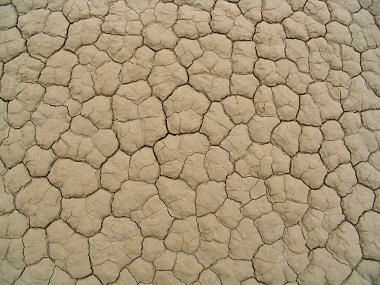Playas are the dry, level beds of ancient
lakes which are found in desert country throughout the southern
Southwest. Normally dry, playas occasionally fill with water, sometimes
no more than a few inches deep over many square miles, after a heavy summer rain or during spring snowmelt.
These shallow lakes usually last no more than a few days or weeks,
evaporating to leave behind a large expanse of mudflats drying in the
sun. Playas were named by Spanish explorers for their resemblance to
beaches.
many square miles, after a heavy summer rain or during spring snowmelt.
These shallow lakes usually last no more than a few days or weeks,
evaporating to leave behind a large expanse of mudflats drying in the
sun. Playas were named by Spanish explorers for their resemblance to
beaches.
|
The playa at right was
photographed at the Racetrack in Death Valley National Park.
|
Playas are
characteristic of desert areas and are maintained by climates that are
drier than they are wet, where the combination of relentless sun, wind
and aridity can evaporate more water from the land than falls in a
year. Most of the Southwest's playas formed thousands of years ago
during the Pleistocene period when the climate in the Southwest was
cooler and wetter. Precipitation eroded mountains and streams carried
sediments to low level basins between mountain ranges which filled
lakes with fine sand and silt. As the climate warmed and dried
10,000-12,000 years ago, the streams dried up and the lakes
evaporated, leaving their flat beds to dry and harden.
|

